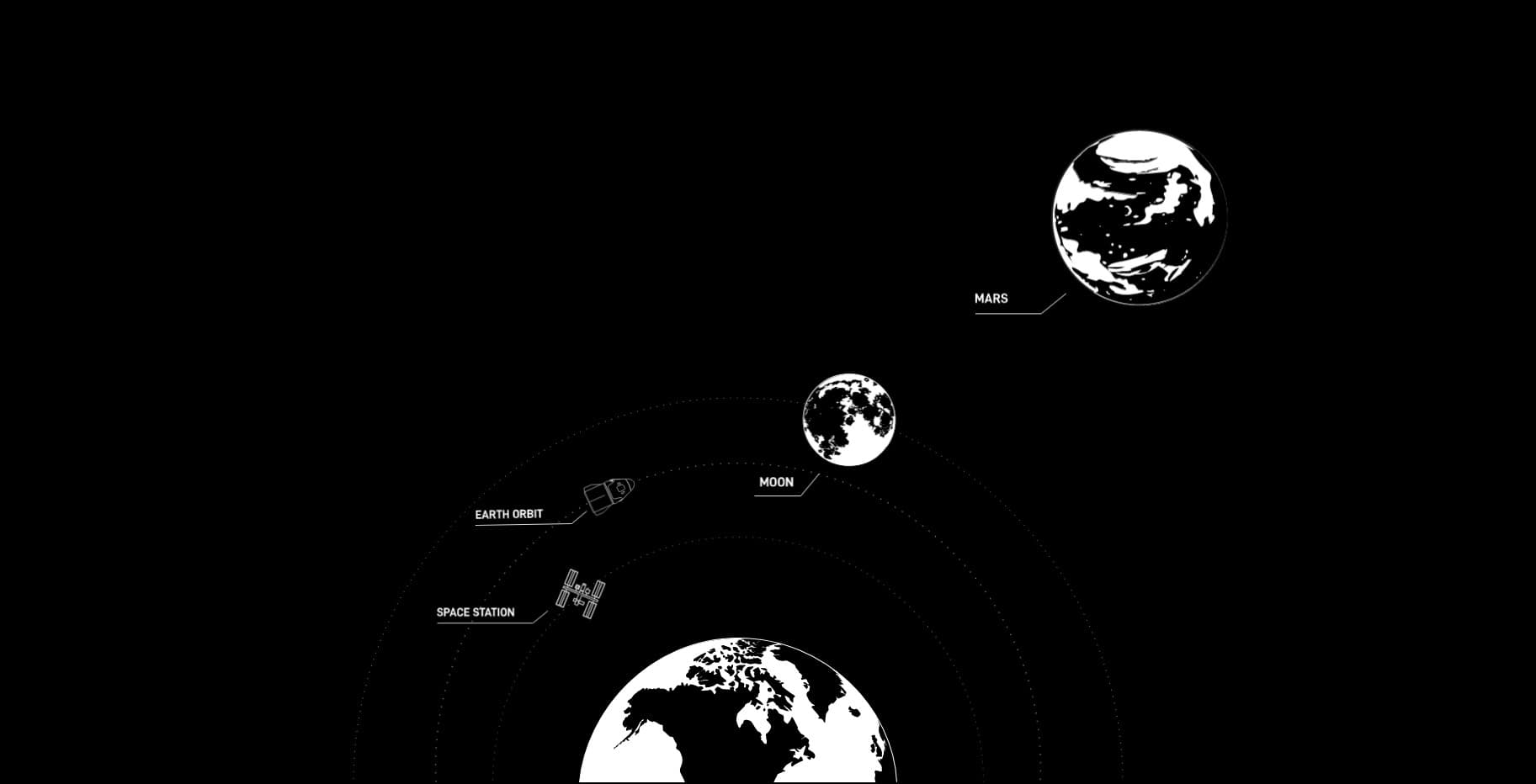Destinations
To be able to determine where we are heading first, we'll have to assess our current situation properly. So, let's do that. What's the deal?
Reading Time: minute
Audiobook: 3 minutes

Our options
Wherever we're going, one of the main things we're looking for is living space. Sure enough, at first we're more likely to look for probes to extract and examine on our home planet, similarly to how we currently are with the Moon and Mars. At some point in time our reasons to go out into space will be colonization though, which is the focus of the thought experiment we're going here, so let's think about that for a second.
| Mercury | Venus | Earth | Mars | Jupiter | Europa (Moon) | Solar System | |
|---|---|---|---|---|---|---|---|
| Distance (km) | 77m | 61m | 0 🤯 | 100m | 590m | 628m | 14 billion |
| Avg. Temp. | 167°C | 464°C | 15°C | −65°C | −110°C | −130°C | -273°C |
| Pressure (bar) | 0 | 90 | 1 | 0.007 | ❓ | 0 | 0 |
| Air | ❌ | ❌ | ✔️ | ❌ | ❌ | ✔️ | ❌ |
| Water | ❓ | ❌ | ✔️ | ✔️ | ✔️ | ✔️ | ❌ |
I only listed the two nearest planets to every side of earth for simplicity reasons. It doesn't go any further than mercury on the side towards the sun and Jupiter already is absurdly far away so there was no point in including Saturn etc.
Mercury
Mercury doesn't look like a realistic contestant for colonization just by looking at it's average temperature, it's low distance to the sun makes it a difficult place to be in to say the least, regarding solar flares and the sun's ejection of plasma waves.
Venus
Now looking at what I said about Mercury, you might want to disregard Venus in a blink of an eye. Based on this table, you would be right. But Venus might be a pretty good contestant at a later point in time where we have the technology to build infrastructure in the clouds of Venus which are far more likely to be habitable than the absolutely horrific conditions on it's surface. More on that in the Venus (opens in a new tab) section.
Earth
Apart from the pretty enjoyable weather conditions there's an increasingly annoying species running around that's apparently trying to ruin the planet. Might have to watch out for those if you ever go for a visit.
Mars
Mars has a somewhat decent temperature, certainly not survivable without a lot of thermal clothing, but definitely survivable with some form of preparation. However, the marsian atmosphere is just about 1% as thick as ours, meaning solar radiation is much higher and the pressure of Mars is way too low to support human lifes without a special suit. It does have water though, so we might want to keep it in mind. After all, it's the first of planets that is habitable as long as we wear suits outside.
Jupiter
Jupiter does have water but we do not know it's atmospheric pressure and the distance to Jupiter makes it a horrible option for a first colonization target due to the long travel time slowing down/delaying the initial colonization waves. However, we have to re-evaluate Jupiter as an option as soon as we learn more about it and have gained some experience in planetary colonization.
Europa (Jupiter Moon)
Europa is far away but it has air, it has tons and tons of water and might actually support life from scratch, meaning there could already be life in the vast oceans of Europa which are estimated to be up to 200 kilometers deep. How mad is that? Imagine oceans that are 100-200 kilometers deep, whereas our deepest point in Earth's oceans is 11 kilometers deep. That's exactly why the NASA is sending the Europa Clipper (opens in a new tab) to check for Europa's habitability. Similar to Jupiter, it is too far away to be considered for our first colonization due to the travel time being over 5 years but we might very well come back to this moon of Jupiter at a later point in time.
Solar System Borders
I included this to show that nothing outside of our solar system is a realistic target for human exploration nor colonization in the near or even distant future, as long as we are unable to invent working Alcubierre drives (opens in a new tab) (warp drives). If that's the case, the Trappist System (which had 3 billion more years to grow life than Earth) is very probably going to be our main mission target, but more on that later (opens in a new tab).
Summary
❌ Mercury: Too hot and too close to the sun
❌ Venus: Too hot on the surface
✔️ Mars: Survivable with special spacesuits
❌ Jupiter: Too far away for now
❌ Europa: Too far away for now
❌ Solar System Borders: Too far away for now
Looks like we just so happen to have no other option than Mars, no matter the eventual complications it might put us through. In the next chapter, before taking a more in-depth look at our red neighbor, we'll look into how we're actually trying to get there: Rockets.
Additional Resources
- Feel free to follow the news around NASA's upcoming Europa Clipper mission, it's pretty exciting.